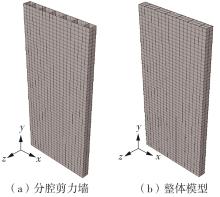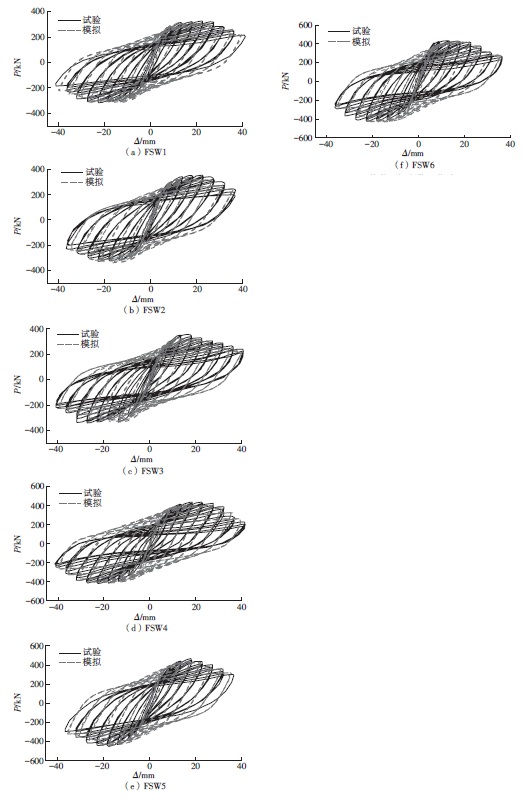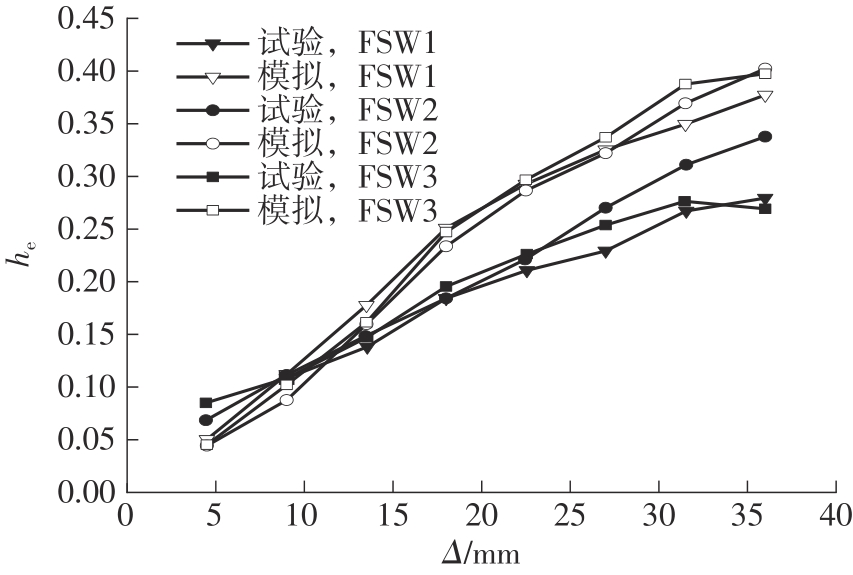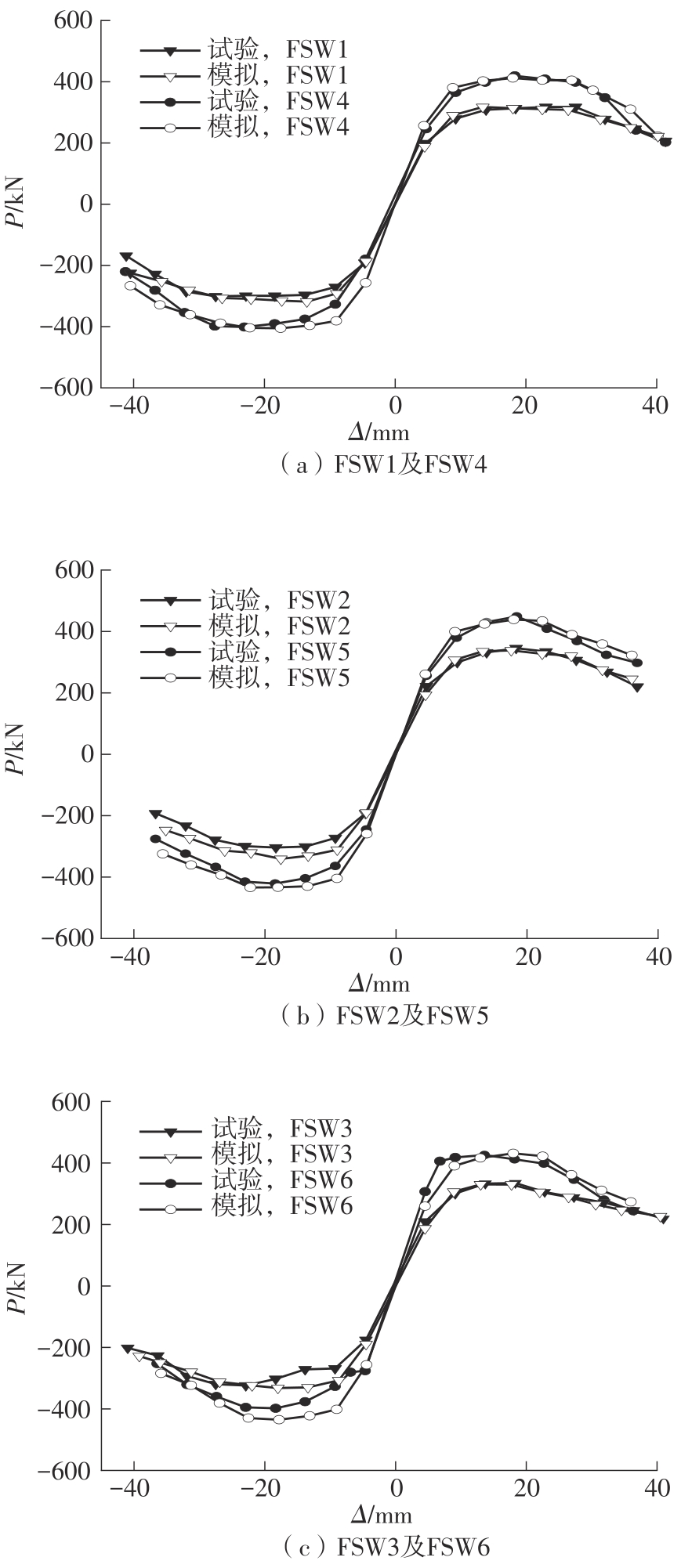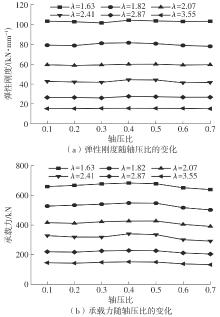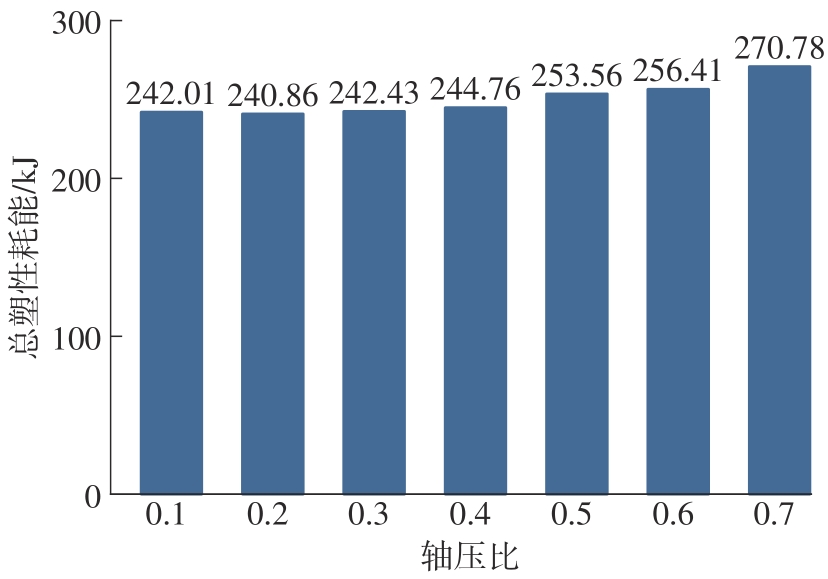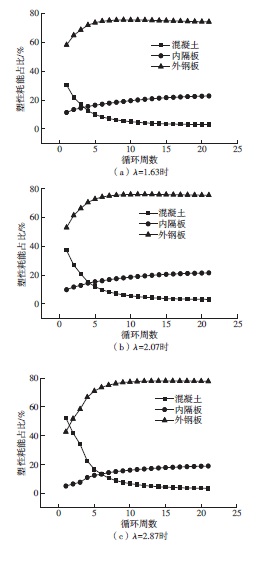Journal of South China University of Technology(Natural Science Edition) ›› 2024, Vol. 52 ›› Issue (1): 15-25.doi: 10.12141/j.issn.1000-565X.220828
• Structural Fatigue and Damage • Previous Articles Next Articles
Seismic Performance Analysis of Welded Multi-Cavity Double Steel Plate-Concrete Composite Shear Wall
DING Faxing1 CAI Yongqiang1 WANG Liping1 SUN Hao1 LÜ Fei1 HUANG Xiuwen2
- 1.School of Civil Engineering,Central South University,Changsha 410075,Hunan,China
2.China Railway Third Bureau Group Co. ,Ltd. ,Taiyuan 030000,Shanxi,China
-
Received:2022-12-26Online:2024-01-25Published:2023-06-19 -
About author:丁发兴(1979-),男,教授,博士生导师,主要从事钢-混凝土组合结构研究。E-mail:dinfaxin@csu.edu.cn -
Supported by:the National Natural Science Foundation of China(51978664)
CLC Number:
Cite this article
DING Faxing, CAI Yongqiang, WANG Liping, et al.. Seismic Performance Analysis of Welded Multi-Cavity Double Steel Plate-Concrete Composite Shear Wall[J]. Journal of South China University of Technology(Natural Science Edition), 2024, 52(1): 15-25.
share this article
Table 2
Comparison of the simulated ductility coefficients with the experimental ones"
| 试件 | 加载方向 | 试验结果 | 有限元模拟结果 | ||||
|---|---|---|---|---|---|---|---|
| Δy/mm | Δu/mm | μ | Δy/mm | Δu/mm | μ | ||
| FSW1 | + | 7.51 | 31.19 | 4.12 | 8.33 | 33.69 | 4.04 |
| - | 7.61 | 33.55 | 4.41 | 8.29 | 33.74 | 4.07 | |
| FSW2 | + | 7.20 | 29.25 | 4.06 | 7.86 | 30.77 | 3.92 |
| - | 7.41 | 29.67 | 4.00 | 7.83 | 30.89 | 3.94 | |
| FSW3 | + | 7.27 | 28.42 | 3.91 | 7.88 | 31.12 | 3.95 |
| - | 8.49 | 33.13 | 3.90 | 7.93 | 30.84 | 3.89 | |
| FSW4 | + | 7.95 | 31.16 | 3.92 | 8.45 | 32.28 | 3.82 |
| - | 10.32 | 33.07 | 3.21 | 8.51 | 32.75 | 3.85 | |
| FSW5 | + | 8.17 | 26.09 | 3.19 | 7.95 | 31.41 | 3.95 |
| - | 7.88 | 28.40 | 3.60 | 8.02 | 31.09 | 3.88 | |
| FSW6 | + | 6.38 | 25.70 | 4.03 | 7.78 | 30.34 | 3.90 |
| - | 6.67 | 26.45 | 3.97 | 7.84 | 30.75 | 3.92 | |
Table 6
Variations of total plastic energy dissipation and plastic energy dissipation ratio of each component with axial compression ratio of composite shear wall model"
| 剪跨比 | 轴压比 | 总塑性耗能/kJ | 核心混凝土塑性耗能/kJ | 内隔板塑性耗能/kJ | 外钢板塑性耗能/kJ |
|---|---|---|---|---|---|
| 2.41 | 0.1 | 242.01(100.0%) | 7.11(3.0%) | 47.52(19.6%) | 187.38(77.4%) |
| 2.41 | 0.2 | 240.86(99.5%) | 7.26(3.0%) | 48.25(20.0%) | 185.36(77.0%) |
| 2.41 | 0.3 | 242.43(100.2%) | 8.01(3.3%) | 49.85(20.6%) | 184.57(76.1%) |
| 2.41 | 0.4 | 244.76(101.1%) | 9.06(3.7%) | 51.91(21.2%) | 183.80(75.1%) |
| 2.41 | 0.5 | 253.56(104.8%) | 10.33(4.1%) | 55.33(21.8%) | 187.90(74.1%) |
| 2.41 | 0.6 | 256.41(106.0%) | 13.22(5.2%) | 57.29(22.3%) | 185.90(72.5%) |
| 2.41 | 0.7 | 270.78(111.9%) | 17.08(6.3%) | 61.00(22.5%) | 192.70(71.2%) |
Table 4
Variation of elastic stiffness with shear span ratio of composite shear wall model"
| 剪跨比 | 不同轴压比下的弹性刚度/(kN·mm-1) | ||||||
|---|---|---|---|---|---|---|---|
| 0.1 | 0.2 | 0.3 | 0.4 | 0.5 | 0.6 | 0.7 | |
| 1.63 | 103.26 | 102.70 | 101.53 | 104.26 | 103.52 | 102.95 | 103.21 |
| 1.82 | 79.11 | 78.74 | 81.04 | 81.58 | 80.66 | 78.87 | 77.97 |
| 2.07 | 59.35 | 58.66 | 59.22 | 59.85 | 59.94 | 59.10 | 59.41 |
| 2.41 | 42.66 | 42.04 | 41.72 | 44.32 | 44.07 | 41.27 | 41.56 |
| 2.87 | 26.41 | 26.44 | 25.99 | 27.58 | 27.20 | 26.67 | 26.67 |
| 3.55 | 15.19 | 15.23 | 15.48 | 15.57 | 15.47 | 15.45 | 15.06 |
Table 5
Variation of bearing capacity with shear span ratio of composite shear wall model"
| 剪跨比 | 不同轴压比下的承载力/kN | ||||||
|---|---|---|---|---|---|---|---|
| 0.1 | 0.2 | 0.3 | 0.4 | 0.5 | 0.6 | 0.7 | |
| 1.63 | 659.31 | 667.30 | 677.23 | 683.40 | 678.58 | 651.39 | 639.37 |
| 1.82 | 527.68 | 534.04 | 540.51 | 548.61 | 547.06 | 516.98 | 502.14 |
| 2.07 | 416.07 | 411.22 | 421.93 | 426.42 | 427.04 | 404.28 | 390.64 |
| 2.41 | 328.30 | 318.64 | 318.18 | 340.63 | 335.26 | 301.06 | 291.33 |
| 2.87 | 219.77 | 217.02 | 225.16 | 227.93 | 226.40 | 211.39 | 204.18 |
| 3.55 | 145.42 | 142.34 | 148.26 | 151.74 | 149.95 | 137.90 | 132.12 |
Table 8
Variations of total plastic energy dissipation and plastic energy dissipation ratio of each component with shear span ratio of composite shear wall model"
| 剪跨比 | 轴压比 | 总塑性耗能/kJ | 核心混凝土塑性耗能/kJ | 内隔板塑性耗能/kJ | 外钢板塑性耗能/kJ |
|---|---|---|---|---|---|
| 1.63 | 0.3 | 547.83(100.0%) | 16.86(3.1%) | 124.87(22.8%) | 406.10(74.1%) |
| 1.82 | 0.3 | 433.70(79.2%) | 13.68(3.2%) | 97.77(22.5%) | 322.25(74.3%) |
| 2.07 | 0.3 | 333.17(60.8%) | 10.35(3.1%) | 71.62(21.5%) | 251.20(75.4%) |
| 2.41 | 0.3 | 242.43(44.3%) | 8.01(3.3%) | 49.85(20.6%) | 184.57(76.1%) |
| 2.87 | 0.3 | 164.82(30.1%) | 5.48(3.3%) | 31.08(18.9%) | 128.25(77.8%) |
| 3.55 | 0.3 | 100.83(18.4%) | 3.86(3.8%) | 17.02(16.9%) | 79.96(79.3%) |
| 1 | LINK R A, ELWI A E .Composite concrete-steel plate walls:analysis and behavior[J].Journal of Structural Engineering,1995,121(2):60-71. |
| 2 | 聂建国,卜凡民,樊健生 .低剪跨比双钢板-混凝土组合剪力墙抗震性能试验研究[J].建筑结构学报,2011,32(11):74-81. |
| NIE Jianguo, BU Fanmin, FAN Jiansheng .Experimental study on seismic performance of double steel plate-concrete composite shear wall with low shear span ratio[J].Journal of Building Structures,2011,32(11):74-81. | |
| 3 | 卜凡民,聂建国,樊健生 .高轴压比下中高剪跨比双钢板-混凝土组合剪力墙抗震性能试验研究[J].建筑结构学报,2013,34(4):91-98. |
| BU Fanmin, NIE Jianguo, FAN Jiansheng .Experimental study on seismic performance of double steel plate-concrete composite shear wall with medium and high shear span ratio under high axial compression ratio[J].Journal of Building Structures,2013,34(4):91-98. | |
| 4 | 聂建国,卜凡民,樊健生 .高轴压比、低剪跨比双钢板-混凝土组合剪力墙拟静力试验研究[J].工程力学,2013,30(6):60-66. |
| NIE Jian-guo, BU Fan-min, FAN Jian-sheng .Quasi-static experimental study of double steel plate-concrete composite shear wall with high axial compression ratio and low shear span ratio[J].Engineering Mechanics,2013,30(6):60-66. | |
| 5 | 李盛勇,聂建国,刘付钧,等 .外包多腔钢板-混凝土组合剪力墙抗震性能试验研究[J].土木工程学报,2013,46(10):26-38. |
| LI Shengyong, NIE Jianguo, LIU Fujun,et al .Experimental study on seismic performance of outsourced multi-cavity steel plate-concrete composite shear wall[J].China Civil Engineering Journal,2013,46(10):26-38. | |
| 6 | NIE J G, HU H S, FAN J S,et al .Experimental study on seismic behavior of high-strength concrete filled double-steel-plate composite walls[J].Journal of Constructional Steel Research,2013,88(9):206-219. |
| 7 | 马晓伟,聂建国,陶慕轩,等 .双钢板-混凝土组合剪力墙压弯承载力数值模型及简化计算公式[J].建筑结构学报,2013,34(4):99-106. |
| MA Xiaowei, NIE Jianguo, TAO Muxuan,et al .Numerical model and simplified calculation formula of bending bearing capacity of double steel plate-concrete composite shear wall[J].Journal of Building Structures,2013,34(4):99-106. | |
| 8 | 邵建华,顾强,申永康 .钢板剪力墙抗震性能的有限元分析[J].华南理工大学学报(自然科学版),2008,36(1):128-133. |
| SHAO Jian-hua, GU Qiang, SHEN Yong-kang .Finite element analysis of seismic performance of steel plate shear wall[J].Journal of South China University of Technology (Natural Science Edition),2008,36(1):128-133. | |
| 9 | 刘鸿亮,蔡健,杨春,等 .带约束拉杆双层钢板内填混凝土组合剪力墙抗震性能试验研究[J].建筑结构学报,2013,34(6):84-92. |
| LIU Hongliang, CAI Jian, YANG Chun,et al .Experimental study on seismic performance of concrete composite shear wall filled with double-layer steel plate with constrained tie rod[J].Journal of Building Structures,2013,34(6):84-92. | |
| 10 | 李健,罗永峰,郭小农,等 .双层钢板组合剪力墙抗震性能试验研究[J].同济大学学报(自然科学版),2013,41(11):1636-1643. |
| LI Jian, LUO Yongfeng, GUO Xiaonong,et al .Experimental study on seismic performance of double-layer steel plate composite shear wall[J].Journal of Tongji University (Natural Science Edition),2013,41(11):1636-1643. | |
| 11 | 丁朝辉,江欢成,曾菁,等 .双钢板-混凝土组合墙的大胆尝试——盐城电视塔结构设计[J].建筑结构,2011,41(12):87-91. |
| DING Zhaohui, JIANG Huancheng, ZENG Jing,et al .An innovative application of SCS composite wall:structural design of Yancheng TV tower[J].Building Structure,2011,41(12):87-91. | |
| 12 | 汤序霖,丁昌银,陈庆军,等 .带加劲肋多腔双层钢板-混凝土组合剪力墙的抗震性能试验[J].工程力学,2017,34(12):150-161. |
| TANG Xu-lin, DING Chang-yin, CHEN Qing-jun,et al .Seismic performance test of multi-cavity double-cavities double-layer steel plate and concrete composite shear wall with stiffener[J].Engineering Mechanics,2017,34(12):150-161. | |
| 13 | 王来,马江霖,李昕,等 .带拉条多腔钢板混凝土组合剪力墙抗震性能研究[J].山东科技大学学报(自然科学版),2019,38(5):46-57. |
| WANG Lai, MA Jianglin, LI Xin,et al .Study on seismic performance of composite shear wall with multi-cavity steel plate with tension strips[J].Journal of Shandong University of Science and Technology (Natural Science Edition),2019,38(5):46-57. | |
| 14 | HE W, WAN Y, LI Y,et al .Experimental study on seismic behaviors of the welded L-shaped double steel plate-concrete composite shear wall[J].Journal of Constructional Steel Research,2021,187:106944/1-12. |
| 15 | DING F X, CAO Z Y,LYU F,et al .Practical design equations of the axial compressive capacity of circular CFST stub columns based on finite element model analysis incorporating constitutive models for high-strength materials[J].Case Studies in Construction Materials,2022,16:e01115/1-23. |
| 16 | 丁发兴,吴霞,向平,等 .多类混凝土和各向同性岩石损伤比强度准则[J].土木工程学报,2021,54(2):50-64,73. |
| DING Faxing, WU Xia, XIANG Ping,et al .Damage ratio strength criterion for various types of concrete and isotropic rock[J].China Civil Engineering Journal,2021,54(2):50-64,73. | |
| 17 | 孙浩,徐庆元,丁发兴,等 .循环荷载下钢管混凝土墩柱塑性大变形分析[J].铁道科学与工程学报,2023,20(3):973-985. |
| SUN Hao, XU Qingyuan, DING Faxing,et al .Analysis of large plastic deformation of concrete-filled steel tube pier under cyclic loading[J].Journal of Railway Science and Engineering,2023,20(3):973-985. | |
| 18 | DING F X, YIN G A, WANG L P,et al .Seismic performance of a non-through-core concrete between concrete-filled steel tubular columns and reinforced concrete beams[J].Thin-Walled Structures,2017,110:14-26. |
| 19 | 谷利雄,丁发兴,张鹏,等 .钢‒混凝土组合简支梁滞回性能非线有限元分析[J].工程力学,2013,30(1):301-306. |
| GU Li-xiong, DING Fa-xing, ZHANG Peng,et al .Nonlinear finite element analysis of hysteresis performance of steel-concrete composite simply supported beam[J].Engineering Mechanics,2013,30(1):301-306. | |
| 20 | 王强 .多腔钢板‒混凝土组合剪力墙抗震性能试验研究及有限元分析[D].哈尔滨:哈尔滨工业大学,2016. |
| [1] | CHEN Qingjun, LI Bingzhou, CHEN Yinian, et al. Seismic Performance of Hoop Head Tenon Frame Structure Reinforced by Sparrow Brace Type Damper [J]. Journal of South China University of Technology(Natural Science Edition), 2023, 51(4): 9-20. |
| [2] | HUANG Haibin, WANG Yanchao, LIU Yazhou, et al. Seismic Performance of CFT Column-to-Beam Joints with Detached Vertical Stiffeners [J]. Journal of South China University of Technology (Natural Science Edition), 2020, 48(3): 55-66. |
| [3] |
ZENG Fanliang HUANG Yansheng ZHOU Jing.
Reliability Verification for Seismic Capacity Utilization Factors of Structure
|
| [4] | GUO Meng LIU Zhi-yuan HUANG Wei WANG Shuang-jiao YUAN Quan . Experiment on Seismic Performance of Earthquake Damage Frame Strengthened with Aerated Concrete Block Composite Wall [J]. Journal of South China University of Technology (Natural Science Edition), 2016, 44(10): 117-124. |
| [5] |
Lei Zhen Qu Jun-tong Wang Yong.
Seismic Performance of FRP-Strengthened Seismically-Damaged RC-Brick Masonry Walls with Opening
[J]. Journal of South China University of Technology (Natural Science Edition), 2015, 43(7): 84-91.
|
| [6] | Yang Chun Pan Jian- ming Cai Jian Liao Xiang- sheng Li Guang- xing . Evaluation of Seismic Performances of Super High- Rise Frame- Core Wall Structure [J]. Journal of South China University of Technology (Natural Science Edition), 2013, 41(6): 84-90. |
| [7] | Yang Chun Li Guang-xing Wu Yi Chen Liang-xing Zhang Chun-mei. Assessment of Seismic Performances of Overrun SRCFrame-Supported Shear Wall Structure [J]. Journal of South China University of Technology (Natural Science Edition), 2013, 41(3): 35-42. |
| [8] | Lei Zhen Zhou De-yuan Wang Ji-bing. Seismic Performances of Masonry Walls Strengthened with BasaltFiber-Reinforced Polymer [J]. Journal of South China University of Technology (Natural Science Edition), 2013, 41(3): 43-49,75. |
| [9] | Xu Yan Duan Xin-zhi Li Jian-zhong. Analysis of Nonlinear Seismic Response of Cable-Stayed Bridge Subjected to Longitudinal Strong Ground Motions [J]. Journal of South China University of Technology(Natural Science Edition), 2012, 40(6): 132-138. |
| [10] | Han Xiao-lei Chen Xue-wei Dai Jin-hua Cheang Jack He Wei-qiu . Numerical Analysis for Low-Cyclic Loading Test of Shear Walls Based on OpenSEES [J]. Journal of South China University of Technology (Natural Science Edition), 2008, 36(12): 7-12. |
| [11] | Shao Jian-hua Gu Qiang Shen Yong-kang. Finite Element Analysis of Seismic Performance of Steel Plate Shear Walls [J]. Journal of South China University of Technology (Natural Science Edition), 2008, 36(1): 128-133. |
| [12] | Du Qun-gui Zou Jian-huang Liu Shao-hong. FE Analysis and Application of the Thermal Field in the Interior Decoration Mould of Auto Ceiling [J]. Journal of South China University of Technology(Natural Science Edition), 2004, 32(12): 51-55. |
| Viewed | ||||||
|
Full text |
|
|||||
|
Abstract |
|
|||||


